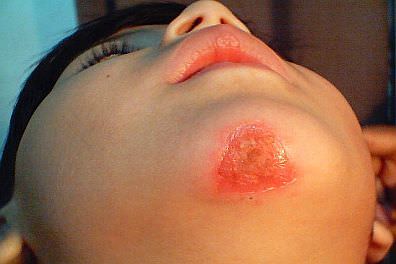Impetigo
What is Impetigo?
 Impetigo is a skin infection that is generally caused by one of two bacteria: Group A streptococcus or Staphylococcus aureus. Impetigo usually affects preschool and school age children, especially in the summer months. A child may be more likely to develop impetigo if his skin has already been irritated or injured by other skin problems, such as eczema, poison ivy, insect bites, or skin allergies.
Impetigo is a skin infection that is generally caused by one of two bacteria: Group A streptococcus or Staphylococcus aureus. Impetigo usually affects preschool and school age children, especially in the summer months. A child may be more likely to develop impetigo if his skin has already been irritated or injured by other skin problems, such as eczema, poison ivy, insect bites, or skin allergies.
When impetigo is caused by Group A streptococcus , it begins as tiny blisters. These blisters burst easily to reveal small wet patches of red skin that may weep fluid. Gradually, a tan or yellowish-brown crust covers the affected area, making it look like it has been coated with honey or brown sugar.
Impetigo that is not caused by Group A streptococcus is usually caused by Staphylococcus aureus . This type of impetigo may cause larger fluid-containing blisters that first appear clear, then cloudy. These blisters are more likely to stay intact on the skin without bursting
What are the signs and symptoms of Impetigo?
Impetigo may affect skin anywhere on the body, but commonly occurs around the nose and mouth. Impetigo is characterized by blisters or a honey-colored crust. Impetigo may itch, and it can be spread by scratching. The infection usually spreads along the edges of an affected area, but may also be spread to other areas of the body.
Is Impetigo contagious?
Impetigo is contagious. Children can spread impetigo from one area of the body to another when they scratch infected skin. When someone has impetigo, the infection can spread to other household members on clothing, towels, and bed linens that have touched the person's infected skin. It can also be spread among playmates or classmates who come in contact with infected skin.
How is Impetigo treated?
Impetigo is treated with antibiotics, which are usually given orally. In mild cases, a topical antibiotic cream may be used.
Gently wash areas of infected skin with antibacterial soap daily. If an area of skin is crusted, soak it first in warm, soapy water to remove the crust. It is not necessary to completely remove all of the crust, but it is important to keep the area clean. To keep your child from spreading impetigo to other parts of the body, cover infected areas of skin, if possible, with gauze and tape or a loose bandage. Keep your child's fingernails short.
Duration
With antibiotic treatment, healing should begin within 2-3 days. A child with impetigo may return to school when the infection is not contagious, which is usually about 48 hours after treatment is started.
Prevention
You can help prevent impetigo by following good hygiene practices while caring for your child's skin. Pay special attention to areas of the skin that have been injured, such as cuts, scrapes, bug bites, areas of eczema, and rashes. Keep these areas clean and covered.
If your child is already being treated for impetigo, call the doctor if your child's skin doesn't begin to improve after 3 days of treatment or if a fever develops. If the affected area becomes red, warm, or tender to the touch, notify your child's doctor.